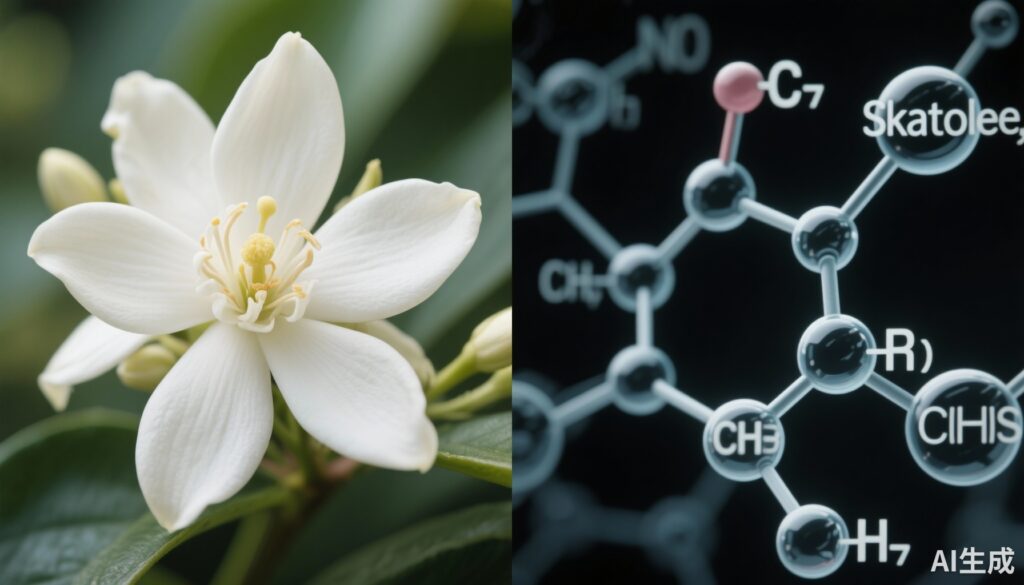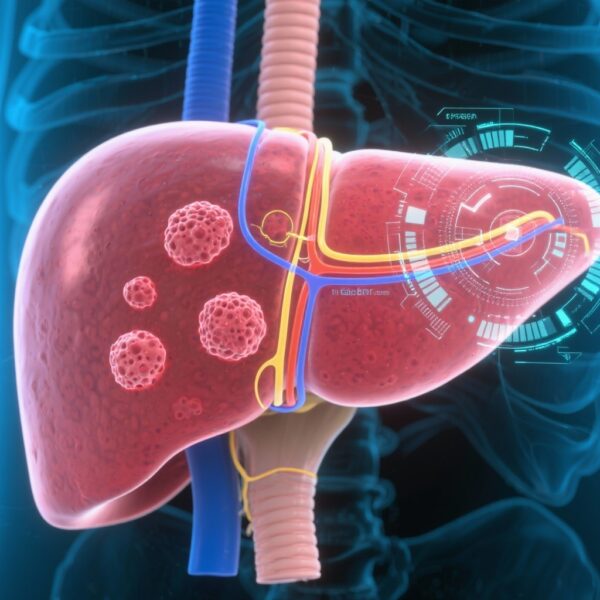Introduction: The Paradox of a Floral-Smelling Fecal Compound
Sweet floral scents typically uplift and soothe us, evoking pleasant memories and relaxation. Surprisingly, some of these sweet aromas share chemical components with substances found in feces. One such compound, skatole (also known by its chemical name, 3-methylindole), exhibits this fascinating duality—it is a major contributor to the odor of feces but, at low concentrations, is associated with floral fragrances found in orange blossoms, jasmine, and other flowers. Furthermore, synthetic skatole is a valued ingredient in many perfumes, enhancing both scent depth and lasting power.
This paradoxical compound, despite its unfortunate name, serves as a biological marker offering insight into our health. Beyond its role in perfume formulation and its contribution to characteristic fecal odor, skatole reflects the complex interactions of our gut microbiota and can indicate the state of our digestive and systemic health.
How Skatole Is Formed Within The Body
Skatole is produced mainly through the fermentation of the amino acid tryptophan by specific intestinal bacteria. In herbivorous and omnivorous animals, including humans, a diverse gut microbiome—with over ten thousand bacterial species—metabolizes undigested tryptophan via two primary pathways: one producing indole, and the other generating indole-3-acetic acid. However, only a subset of bacteria specialize in synthesizing skatole. The production of skatole is influenced by several factors, including the activity levels of metabolic enzymes, precursor concentrations, intestinal microenvironment pH and carbon dioxide levels, as well as the overall gut bacterial community structure.
Dietary habits profoundly affect the fecal odor, as bacterial metabolism of different foods releases various gases. For example, consuming sugary candies containing sorbitol can cause particularly foul fecal odors due to altered bacterial fermentation. Similarly, sulfur-rich foods like eggs, broccoli, cabbage, cauliflower, onions, legumes, and meat produce hydrogen sulfide and related sulfur compounds, which emit a characteristic rotten-egg smell.
Chemical Synthesis of Skatole
Beyond natural production in the gut, skatole can be chemically synthesized through several methods. A commonly used approach involves the heat-induced reaction of glycerol with aniline under controlled conditions. Another pathway utilizes propenal phenylhydrazone and zinc chloride heated in an oil bath at 180°C, while a third relies on the co-melting reaction of proteins with potassium hydroxide. These synthetic methods enable the industrial production of skatole for use in various sectors including perfumery and medicine.
Diverse Applications of Skatole
1. Medical Uses: Skatole exhibits antibacterial, antifungal, and antiviral properties, making it valuable in clinical settings, food sterilization, and agriculture. It helps prevent and treat infections such as pneumonia, diarrhea, enteritis, typhoid fever, and pernicious anemia, and can reduce surgical complications.
2. Fragrance Industry: Despite its association with fecal odor, minute quantities of skatole add depth and lasting power to floral perfumes. It contributes a mature, animalistic nuance reminiscent of civet cat musk and synergizes well with other aroma compounds like phenylacetic acid and macrocyclic ketones.
3. Preservation and Antimicrobial Uses: Skatole helps inhibit harmful microorganisms in food and pharmaceuticals, offering antifungal efficacy against pathogens such as Malassezia and dermatophytes.
4. Agricultural Applications: It protects crops by disrupting pests’ feeding organs and prevents parasitic infections, thereby supporting plant health.
5. Industrial Roles: Used in manufacturing fragrances for cosmetics and food, skatole also displays antioxidant properties valuable in producing storable goods, coatings, rubber, and plastics, enhancing product quality and durability.
Systemic Effects of Indole Compounds Derived From Skatole Precursors
After absorption by intestinal epithelial cells, indole and related compounds enter the bloodstream and influence multiple bodily systems. They play roles in modulating inflammatory bowel diseases, hemorrhagic colitis, colorectal cancer, diabetes, and central nervous system (CNS) inflammation.
Notably, indole-3-propionic acid (a metabolite related to skatole) shows strong antioxidant capacity, protecting pancreatic beta cells from metabolic and oxidative damage, and preventing amyloid protein buildup. This protective mechanism suggests that gut microbial metabolism of tryptophan derivatives significantly contributes to type 2 diabetes prevention.
Indole, Neurodevelopmental, and Neuropsychiatric Connections
Research indicates children with autism spectrum disorders (ASD) tend to have lower fecal indole levels but higher skatole (3-methylindole) concentrations. These compounds relate closely to clostridial species in the gut microbiota, hinting that microbial metabolism may impact ASD pathogenesis.
Elevated plasma indole levels are implicated in hepatic encephalopathy, a neuropsychiatric disorder complicating liver failure, causing marked behavioral and consciousness changes.
Moreover, the NutriNet-Santé cohort study found that urinary indole compound concentrations correlate positively with recurrent depressive symptoms, suggesting microbial metabolism’s role in mood disorders.
Central Nervous System Impact and Neurotoxicity of Sulfated Indole Derivatives
Sulfated indole derivatives produced by gut microbes contribute to CNS diseases. Their accumulation associates with chronic kidney disease and cardiovascular conditions. Renal insufficiency leads to buildup of uremic toxins like sulfated indoles in the brain, impairing neurological function.
These compounds damage neurons and neural stem cells, reduce neurotrophic factors and neurotransmitters, and trigger oxidative stress and neuroinflammation. Activation of CNS glial cells by these toxins propagates inflammation, contributing to neurodegeneration.
Animal studies show mice exposed to elevated sulfated indole toxins develop anxiety, depression-like behaviors, cognitive deficits, and neurodegeneration, paralleling human pathology.
Interpreting Fecal Odor as a Health Indicator
Excessive alcohol consumption can cause drastically foul fecal odor due to gut epithelial and digestive disturbances. Fortunately, dietary adjustments often improve these symptoms.
However, persistent and unusually awful fecal smells — such as putrid or rotten odors lasting over time—may signal serious health issues. Malabsorption syndromes that impede nutrient digestion and absorption can cause prolonged malodor.
Such changes reflect delayed gastrointestinal transit (“poor motility”), allowing prolonged fermentation of feces and increased odor production.
Anyone experiencing sustained changes in fecal odor accompanied by diarrhea, blood in stool, abdominal pain, or fever should seek medical evaluation promptly.
Important Clarifications and Food Industry Practices
It might surprise some to learn that skatole added to foods is not harvested from feces but is chemically refined from petroleum derivatives. Trace amounts of skatole appear in beers, soft drinks, processed meats, cheeses, and other products to impart natural-looking freshness and complex aromas.
Conclusion
Skatole exemplifies nature’s paradox—a compound central to notably unpleasant fecal odors yet valued for its floral scent and multifaceted applications. Its production by gut microbes not only shapes fecal aroma but also serves as a window into intestinal and systemic health.
The emerging links between indole compounds and neurodevelopmental, hepatic, and psychiatric disorders highlight the intricate microbiome-host communication pathways awaiting deeper exploration. Understanding these connections could reveal novel diagnostic biomarkers and therapeutic targets.
For the general public, being mindful of dietary choices affecting gut fermentation and fecal odor can improve wellbeing. Clinicians should consider fecal odor changes as part of the broader clinical picture calling for evaluation.
As science advances, skatole and related metabolites will continue to illuminate health and disease frontiers bridging microbiology, chemistry, and medicine.
Fictional Patient Scenario
John, a 45-year-old man, noticed a persistent rotten egg smell in his stool along with mild abdominal discomfort and intermittent diarrhea. Concerned, he consulted his physician who investigated dietary habits, ruling out sulfur-rich foods and alcohol abuse. Further tests revealed delayed intestinal transit and mild malabsorption. Treatment to restore gut motility and modify diet led to symptom resolution and normalization of stool odor. This case highlights the clinical relevance of fecal odor changes as a health indicator.
References
1. Brunton LL et al. Goodman & Gilman’s The Pharmacological Basis of Therapeutics, 13th Edition, McGraw-Hill, 2017.
2. Patel PS et al. “Role of gut microbial indole production in human health and disease.” Cell Reports, 2020; 30(2): 376-385.
3. Wang Z et al. “Gut flora metabolism of phosphatidylcholine promotes cardiovascular disease.” Nature, 2011; 472:57-63.
4. Xu J et al. “Indole metabolites as mediators of gut-brain communication: implications for neuropsychiatric disorders.” Frontiers in Neuroscience, 2019.
5. NutriNet-Santé cohorts. “Urinary indole metabolites and depression: a prospective observational study.” Psychoneuroendocrinology, 2021; 126:105145.



